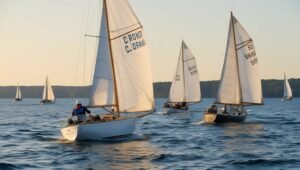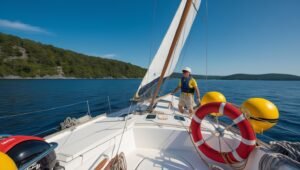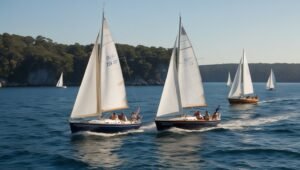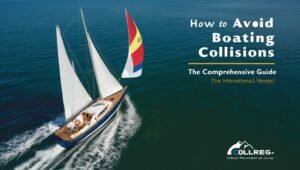
How to Avoid Boating Collisions: The Comprehensive Guide
Sailing is a relaxing and enjoyable activity offering a unique way to connect with nature, experience adventure and spend quality time with friends and family. However, open water, whether on a lake, river, or ocean, presents its challenges and dangers, especially the risk of colliding with another vessel. Unlike road traffic, there are no lanes or traffic signals on water, which can make it difficult to navigate safely without proper knowledge and caution. This guide takes an in-depth look at how to avoid boating collisions and ensure a safe and enjoyable experience on the water.

Understand and follow navigational laws.
Just as drivers must know and obey the laws of the road, boaters must know and follow the maritime laws, known as the “Rules of the Road” or COLREGs (Collision Prevention at Sea (also known as International Regulations). These rules are established by international and national maritime organizations and govern the behavior of ships in various situations to prevent collisions.
Right of way Some vessels have right of way over others depending on their type, size, and situation. For example, powered boats should meet single-sail underpowered boats, and all sails should yield to larger vessels with limited maneuverability.
Giveaway and stand-on vessels A vessel to the right of way is a “stand-on” vessel and must maintain its course and speed. A “giveaway” vessel must take early and sufficient action to avoid a collision, usually by changing course or speed.
Navigating in narrow channels: Vessels navigating in narrow channels or near shores should be on the starboard side (right) of the channel. Smaller boats should avoid blocking larger vessels that are confined to narrow channels.
Maintain a proper vision
Maintaining proper visibility is one of the most fundamental aspects of boating safety. This means constantly monitoring the surroundings for other boats, obstacles, and navigational hazards. A good search should use both sight and hearing to detect any potential hazards.
360 Degree Awareness Boaters must constantly scan the horizon in all directions, not just ahead. This includes looking behind and to the sides, as boats can approach from any direction.
Night and low visibility At night or in fog, rain, or other conditions that reduce visibility, boaters must be even more alert. Use navigation lights, sound signals, and radar (if available) to detect other vessels and avoid collisions.
Assigning a Lookout On large ships or when sailing in crowded or difficult conditions, it is a good idea to assign a specific person to act as a lookout, allowing the captain to control steering and navigation. can pay attention

Understand and use navigational aids.
Navigational aids, such as buoys, markers, and lights, are essential tools for safe boating. They help identify safe routes, mark hazards, and indicate appropriate routes.
Buoys and Markers These floating devices come in a variety of colors, shapes and sizes, each with specific meanings. For example, red and green buoys mark the edges of a channel, with the red buoy on the starboard (starboard) side and the green buoy on the port (port) side when returning to port.
Light signals Different colors and arrangements of lights on vessels and structures indicate their type, size, and activity. For example, a red light indicates the port side of a vessel, while a green light indicates the starboard side.
Acoustic signals Boats use acoustic signals, such as horns or bells, to communicate their intentions, especially in low visibility conditions. Understanding and using these signals correctly can help avoid misunderstandings and potential conflicts.
Operate at a safe speed.
Speed is an important factor in preventing boat collisions. Operating at a safe speed gives you more time to react to potential hazards and reduces the impact force if a collision occurs. Adjusting Speed to Conditions A safe speed depends on a variety of factors, including visibility, traffic density, water conditions, and the maneuverability of your vessel. In crowded areas, narrow channels, or close to shore, ensure you have enough time to respond to unexpected situations.
Wakes and Washes Large wakes at high speeds, can cause problems for other boats, especially smaller or moored vessels. Always consider the effect of your wake on others and slow down when passing other boats or in the no-wake zone.
Stopping Distance Unlike cars, boats do not have brakes. The stopping distance depends on your speed and the size of your vessel. Always keep a safe distance from other boats and obstacles, allowing enough room to slow down or stop if necessary.

Communicate clearly.
Clear communication between boaters can prevent many potential collisions. This includes both verbal communication and the use of navigational signals.
Plan your route and assess hazards.
Effective planning and assessment of potential hazards are essential to avoid collisions.
Pre-Voyage Planning Before heading out, study navigation charts, weather forecasts, and tide tables to plan your route. Identify potential hazards, such as shallow areas, cliffs, or heavy traffic zones, and plan to avoid them.
Continuous Assessment While underway, continuously assess the situation, noting changes in weather, water conditions, or traffic. Be prepared to change your route or speed if necessary.
Predicting the actions of other vessels Try to predict the movements of other vessels based on their speed, direction, and type. For example, a large cargo ship may not be able to change course quickly, so give it a wide berth.
Practice defensive sailing.
Defensive boating involves taking proactive steps to avoid a potential collision, even if you have the right of way.
Assume the worst Always assume that other boaters cannot see you or follow the rules of navigation. Be ready for ridiculous action if needed.
Keep a safe distance: Keep a safe distance from other boats, especially in crowded or narrow areas. Avoid clipping the bows of other vessels or following them too closely.
Avoid distractions: Like driving, distractions can lead to accidents on the water. Stay focused on your surroundings and avoid activities that distract you from safe navigation, such as using a phone or engaging in conversation.
Understand the effects of wind, currents, and waves.
Wind, currents, and waves can significantly affect your boat’s handling and make collision avoidance more difficult.
Wind Strong winds can push your boat around, especially when navigating tight spaces. Be aware of how the wind affects your vessel and compensate by adjusting your course or speed.
Current Current can help or hinder your progress depending on its direction. When crossing currents, angle your boat to maintain a straight course and avoid veering off course.
Waves Large waves can make it difficult to maintain control of your vessel, especially in rough seas. In such cases, reduce speed and angle the waves to minimize impact and avoid capsizing
Invest in and maintain proper equipment
Having the right equipment on board and ensuring it works properly is essential to safe boating.
Navigation lights Make sure your boat is equipped with adequate navigation lights and that they are working properly. Use them during low visibility conditions or at night to make your vessel visible to others.
Radar and GPS These tools can be invaluable in helping you navigate safely, especially in poor visibility or unfamiliar waters. Update your GPS charts regularly and check that your radar is working properly.
Life jackets and safety equipment: Ensure that all passengers have access to life jackets and that other safety equipment, such as fire extinguishers and flares, are readily available and in good condition.
Educate yourself and your staff.
Knowledge and experience are the keys to safe boating. Whether you are a novice or an experienced boater, continued education and training can help you avoid accidents.
Boating Safety Courses Take a boating safety course to learn about navigation rules, emergency procedures, and collision avoidance techniques. Many organizations offer online and in-person courses.
Practice emergency procedures Regularly practice emergency drills with your crew, including man overboard recovery, fire response, and abandon ship. Knowing how to react in an emergency can mean the difference between life and death.
Stay Informed Stay up-to-date with changes in boating laws, navigation rules, and safety guidelines. Join local boating clubs or online forums to share knowledge and experiences with other boaters.

Respect the environment and wildlife.
Environmental awareness is an important aspect of safe and responsible boating. Collisions can occur not only with other boats but also with marine wildlife and underwater obstacles.
Watch for wildlife In areas known for marine life, such as dolphins, whales, or manatees, slow down and keep a sharp lookout. Colliding with a large animal can seriously damage your boat and injure or kill the animal.
Avoid sensitive areas Respect no-entry zones, protected areas, and rocks, which are often marked.
